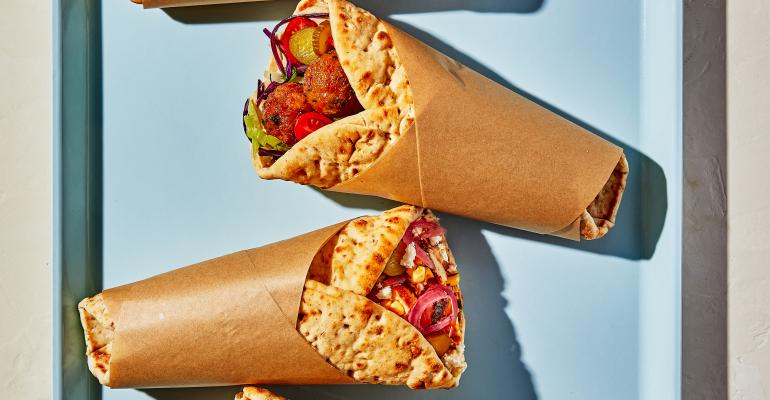Potentially toxic “forever chemicals” known as PFAS — per- and polyfluoroalkyl substances — are pervasive in restaurant to-go packaging, according to tests by Consumer Reports published Thursday.
After testing more than 100 packaging products from 24 large national restaurant chains and grocery stores, Consumer Reports found that nearly half had at least one packaging product with high PFAS levels of more than 100 parts per million, or ppm.
Among the restaurant companies with packaging products with the highest levels were Arby’s and Burger King’s paper bag for cookies, for example, Cava’s fiber tray used for kids meals, Chick-fil-A’s sandwich wrapper, McDonald’s’ paper bag for fries, Nathan’s paper bag for sides, Sweetgreen’s bag for focaccia, and Taco Bell’s bag for crisps.
Arby’s cookie bag, for example, had 457.5 ppm, and Burger King’s bag for cookies or French Toast Sticks had 345.7 ppm. The Whopper wrapper also tested high at 249.7 ppm. Both the kids meal tray and the fiber bowl for grains or salads at Cava were over 500 ppm, as was the sandwich wrapper at Chick-fil-A.
Among the 118 products tested, Nathan’s green stripe bag for sides had the highest PFAS levels at 876 ppm.
Most of the restaurant and retailer packaging tested had products with PFAS levels above 20 ppm, the report found. But almost all had products with PFAS levels below that amount as well, indicating that it is possible to offer to-go options that are less likely to expose food to the chemicals.
Developed in 1938, PFAS refers to a category of some 9,000 substances often used to make packaging grease resistant. They are used to line paper plates and bags, for example, or molded fiber salad bowls. They are also used to make nonstick pans and waterproof gear.
For years, however, concern has been growing about health risks associated with PFAS, which have been linked to immune system suppression, lower birth weight and the increased risk of some cancers, according to the report.
PFAS can leach into food with direct contact. In addition, when the packaging is sent to landfills as trash, the chemicals can contaminate soil and water. If the trash is incinerated, PFAS can contaminate the air.
A growing number of states have adopted legislation to reduce the use of PFAS in food packaging and cookware. In California, for example, legislation goes into effect in 2023 that will restrict the use of PFAS in paper foodservice packaging.
The U.S. Environmental Protection Agency last week announced it will investigate PFAS contamination from containers, and it will notify companies of their obligation to ensure unintentional PFAS contamination does not occur, as required under the Toxics Substances Control Act. The EPA also will remove two PFAS from its Safer Chemical Ingredient List.
In fact, the report notes that the use of PFAS has become so prevalent in the environment that it’s almost impossible to describe packaging as “PFAS free.”
But Consumer Reports notes that efforts by some restaurant companies to limit the use of PFAS in their packaging can make a difference.
“We know from our testing that it is feasible for retailers to use packaging with very low PFAS levels,” said Brian Ronholm, director of food policy at Consumer Reports, in the report. “So the good news is there are steps that companies can take now to reduce their use of these dangerous chemicals.”
Among those tested, chains that say they are phasing out PFAS include McDonald’s, Cava, Chipotle Mexican Grill, Panera Bread, Chick-fil-A, Sweetgreens and Whole Foods Market.
Restaurant Brands International, the parent to Burger King, Popeyes, Firehouse Subs and Tim Hortons, this week updated its sustainability pledge saying it now prohibits use of one type of PFAS, perfluorooctanoic acid (PFOAs) from all paper and packaging products across all its brands. The company said it will phase out all added PFAS from guest-facing packaging globally by the end of 2025 or sooner.
Chick-fil-A Inc. in a statement said it has eliminated intentionally added PFAS from newly produced packaging going forward, but some legacy packaging may still be in restaurants. The chain expects to phase out that supply by the end of summer.
"We've spent the last four years working closely with our suppliers, an independent lab and third-party validator to provide our customers with innovative packaging products that meet all applicable regulatory standards," the company said in a statement. "This is one important step in our ongoing journey to use more sustainable materials in our restaurants."
Cava told Consumer Reports that supply chain challenges have slowed its progress on eliminating added PFAS, but it hoped to complete the transition by the end of this year.
All of the restaurant chains also had products that tested very low for PFAS, the report noted.
Nathan’s hot dog container, for example, had only 9.8 ppm; the foil-lined bag Chick-fil-A uses for its sandwiches had only 10.5 ppm; and Arby’s wrapper for its Classic Beef ‘N Cheddar sandwich tested at 8.5 ppm.
UPDATE: This article has been updated with new information from Chick-fil-A.
Contact Lisa Jennings at [email protected]
Follow her on Twitter: @livetodineout

